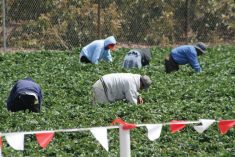No matter how you measure it, Canadian and Alberta farm income took a big, double-digit, hit in 2018.
The two biggest culprits were flat revenues, in part because of trade restrictions, and higher expenses, including for commercial feed, interest and machinery fuel.
For 2018, Canadian farm net cash income fell 20.7 per cent to $11.6 billion, according to Statistics Canada, which described that as the biggest drop since 2003.
But the situation in Alberta was even worse — net cash income plunged to 2.4 billion from 3.5 billion a year earlier.
Read Also

Farming Smarter receives financial boost from Alberta government for potato research
Farming Smarter near Lethbridge got a boost to its research equipment, thanks to the Alberta government’s increase in funding for research associations.
That’s a 31 per cent drop.
However, Canadian and Alberta farmers have seen worse years.
While 2018 saw the lowest Canadian realized net farm income since 2009, it’s still higher when compared in constant dollars (adjusted for inflation) than most of the 1990s and between 2003 and 2007, the analysis said.
Still optimistic
Farmers are facing headwinds, but J.P. Gervais, Farm Credit Canada’s chief agricultural economist, remains optimistic about Canadian agriculture in the long term.
“We are in a downturn, I don’t think there’s any doubt when you have a decline in net cash income of 21 per cent (nationally),” he said. “But we are getting into this from a position of strength. Margins are positive on average, but more operations are faced with tighter margins and in some cases zero margins.
“To put things in perspective, we are back to where we were in 2011 in terms of net cash income… Is this a bad thing? Not necessarily when you account for the tremendous growth in the industry.”
But Gervais was surprised to see Canadian farm expenses in 2018 up by 6.6 per cent.
“Back in September (2018) they were trending at around three, 3.4 and four (per cent) tops,” he said. “Come the end of the year and now they are 6.5 (per cent). That’s a big jump.”
While Canadian net cash income in 2018 fell almost 21 per cent from the year before, realized net income, and total net income declined by even more — 45 and 60 per cent.
Canadian farm receipts, including farm program payments, increased just 0.1 per cent to $62.2 billion, but farm operating expenses jumped 6.5 per cent to $50.6 billion. The difference left Canadian farmers with net cash income of $11.6 billion.
Alberta’s 2018 realized net income and total net income dropped 68 and 88 per cent respectively.
Realized net income fell in every province except New Brunswick, StatsCan said, where an increase in cannabis and potato production lifted receipts by 7.2 per cent.
More than a third of the Canada-wide decrease stemmed from a 68.1 per cent decline in Alberta alone.
Cash is what counts
The province’s 2018 farm cash receipts were down four per cent to $13.6 billion, but farm operating expenses jumped five per cent to $11.15 billion — leaving $2.42 billion in net cash income.
When assessing farm income, Gervais said he prefers net cash income, which is farm receipts minus operating expenses.
“Revenues versus cash costs and that gives you a pretty good idea of what the market environment is,” he said.
Realized net income is net cash income minus depreciation, plus income in kind, while total net farm income is realized net income adjusted to take changes in the value of farm product inventory into account. Both measures have their place, but net cash income is a consistent yardstick by which to measure the state of farmers’ income, Gervais said.
A small change in farm receipts and/or expenses can result in a significant percentage shift in farm income going up or down, he added.
“I don’t want to sugar-coat anything,” Gervais said. “We’ve got market access issues with pulses, for canola. That’s something significant. There’s maybe some upside for some of the grains because of weather challenges in the U.S. But overall I think there are headwinds in 2019.
“But long term I see no reason to change the outlook, which is positive in my mind. The demand for ag commodities is still very strong. The demand for food is strong. We have a dollar at 75 cents (U.S.) that’s supportive of margins. We have Canadian products and a good reputation. All those things are positive. But I don’t want to downplay the fact there are headwinds in the short term that are creating some real challenges for farm operations.”
Rising costs
Farm expenses were up in every province — up more than $3 billion nationally with the largest percentage increase since 2012.
Feed costs were up 9.6 per cent on tight pre-harvest supplies of feed grains, StatsCan said. Interest expenses rose 19.5 per cent on rising average interest rates, while machinery fuel expenses were up 18.1 per cent, and cash wages rose eight per cent from 2017.
On the revenue side, Alberta saw canola receipts drop by 16.1 per cent. Lentil and dry pea receipts were also down, StatsCan said, mainly on India’s pulse crop tariffs.
Nationally, livestock production revenue slipped 0.2 per cent, to $25 billion, in 2018 as hog receipts fell 8.9 per cent on record-high North American inventories. Cattle and calf revenue rose 0.1 per cent on higher marketings against small price decreases.
But there was some good news in a second StatsCan report on quarterly cash receipts.
Alberta saw a jump of $153 million (to $3.99 billion) in the first quarter of the year compared to the first three months of 2018.
However, while livestock income was up, crop cash receipts fell slightly. This was offset by a near doubling of “direct payments,” which includes crop insurance payments and government programs.
Nationally, crop insurance payouts were up 60.6 per cent in the first quarter on a year-over-year basis. Alberta accounted for just over half of those crop insurance payments, on acres left unharvested due to adverse weather.
















